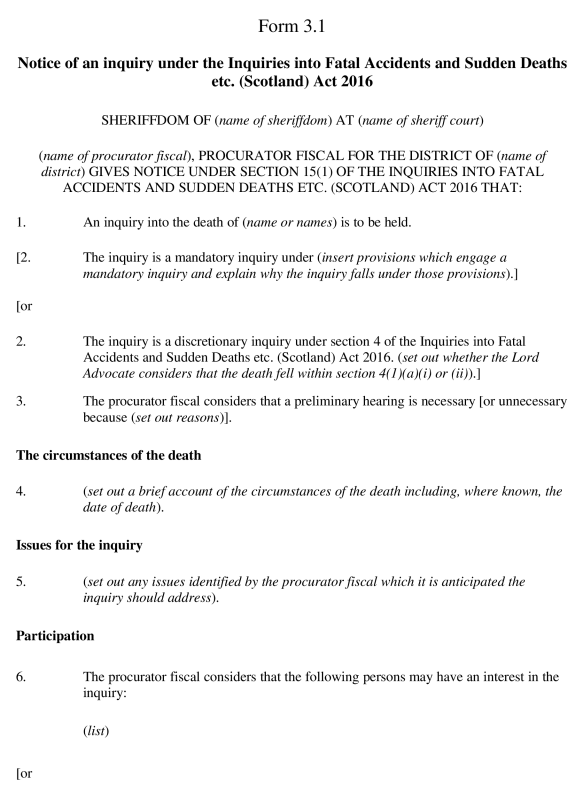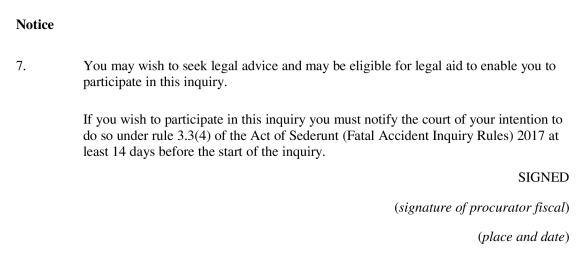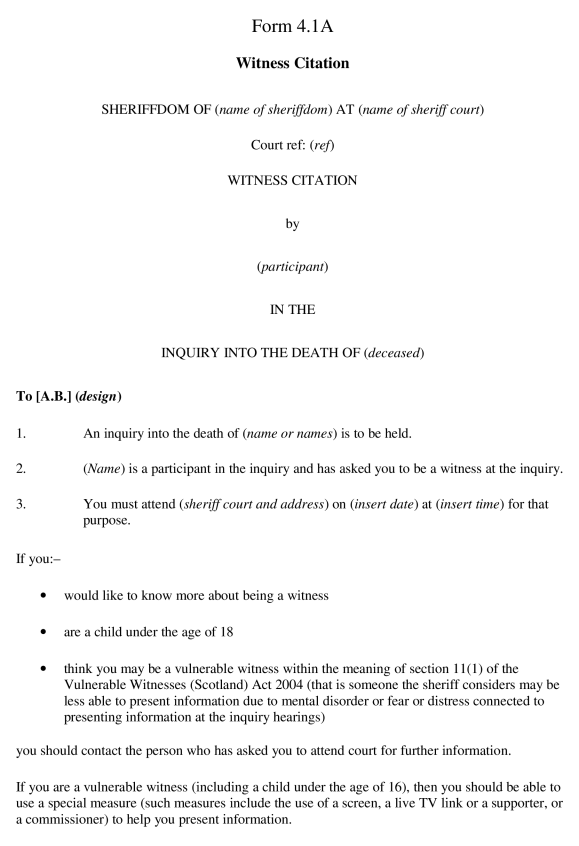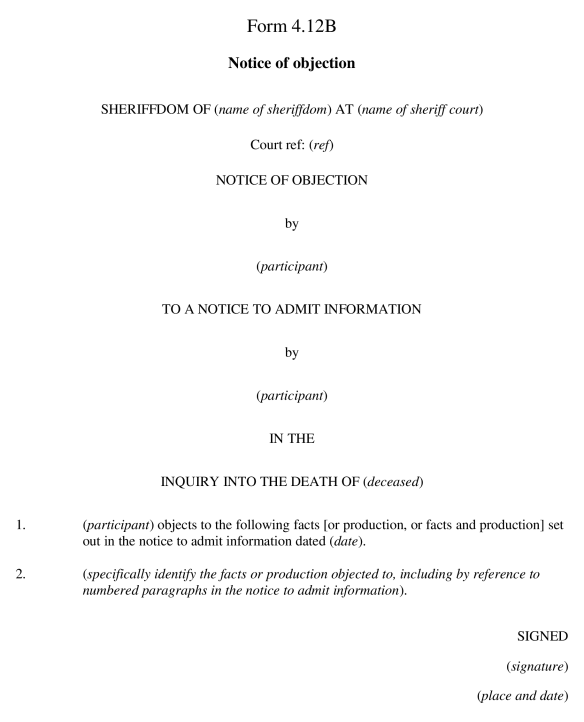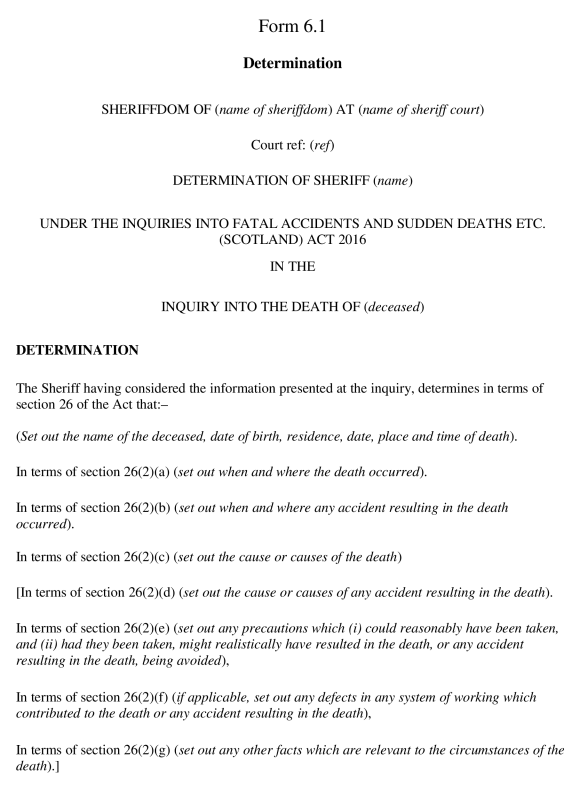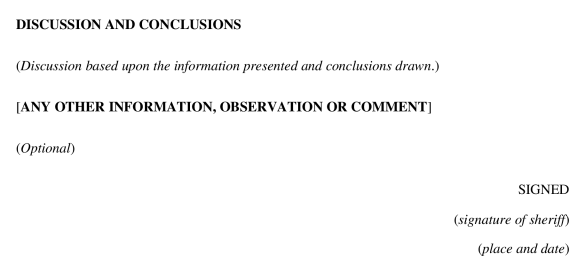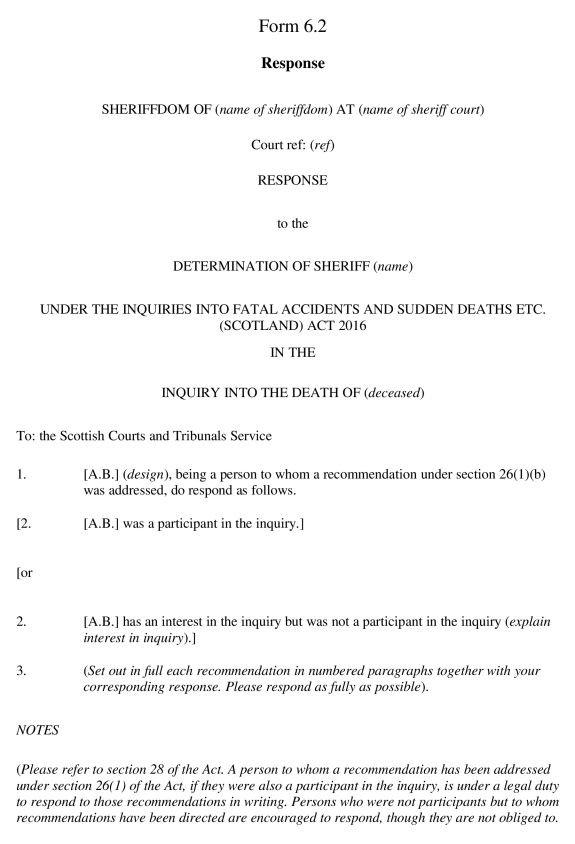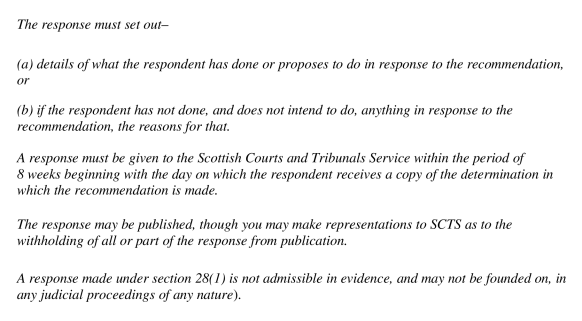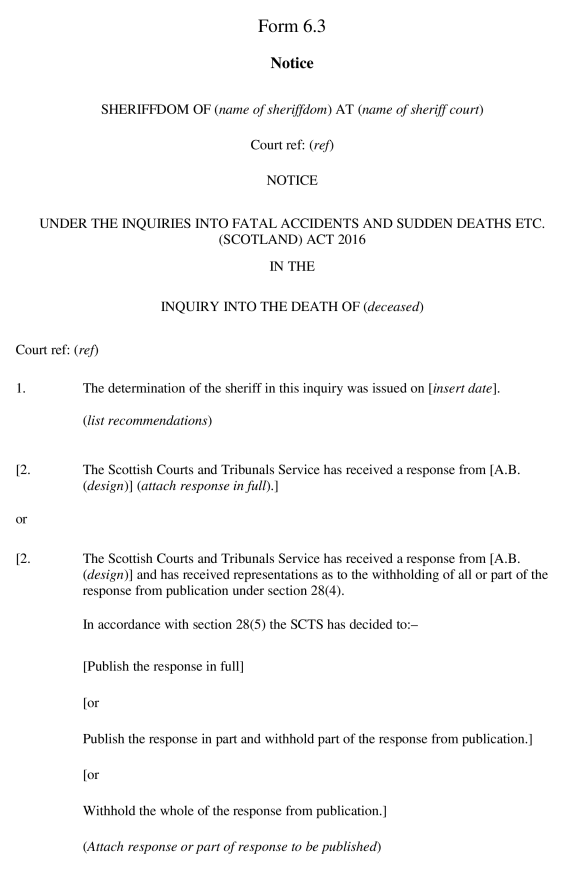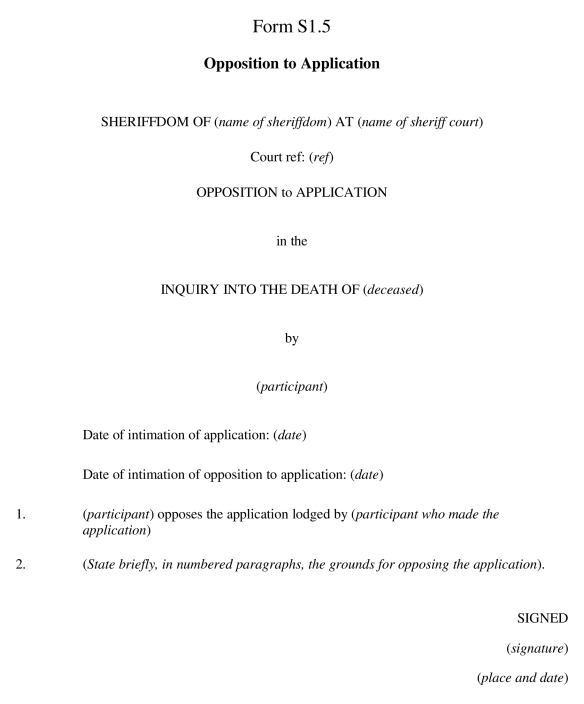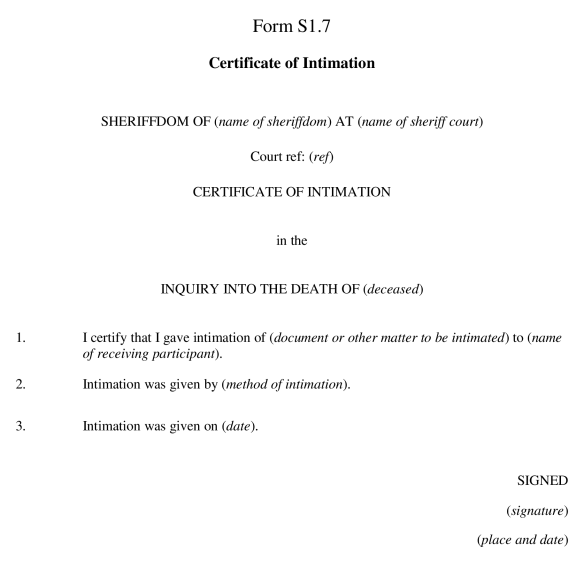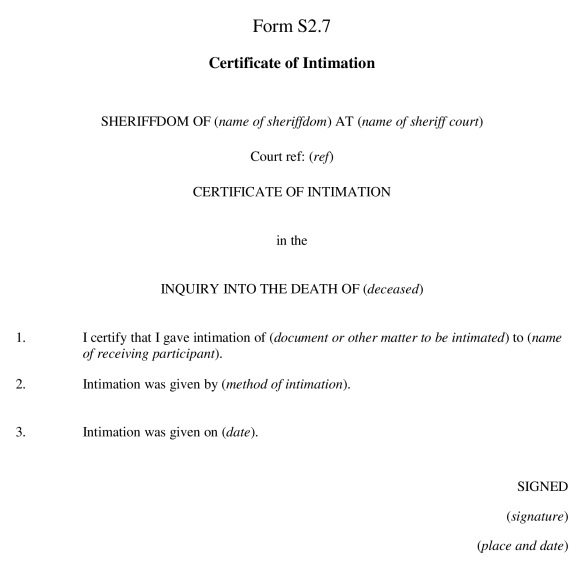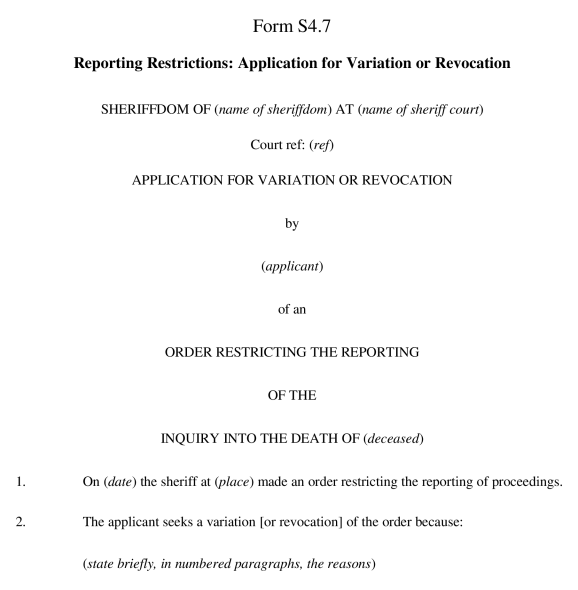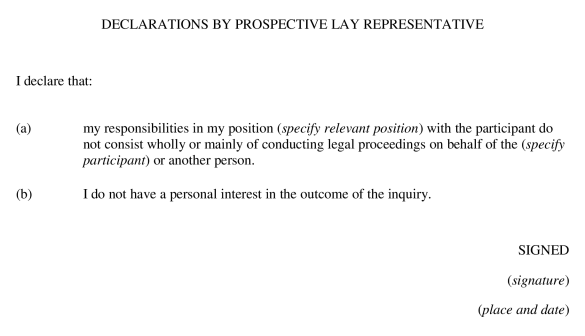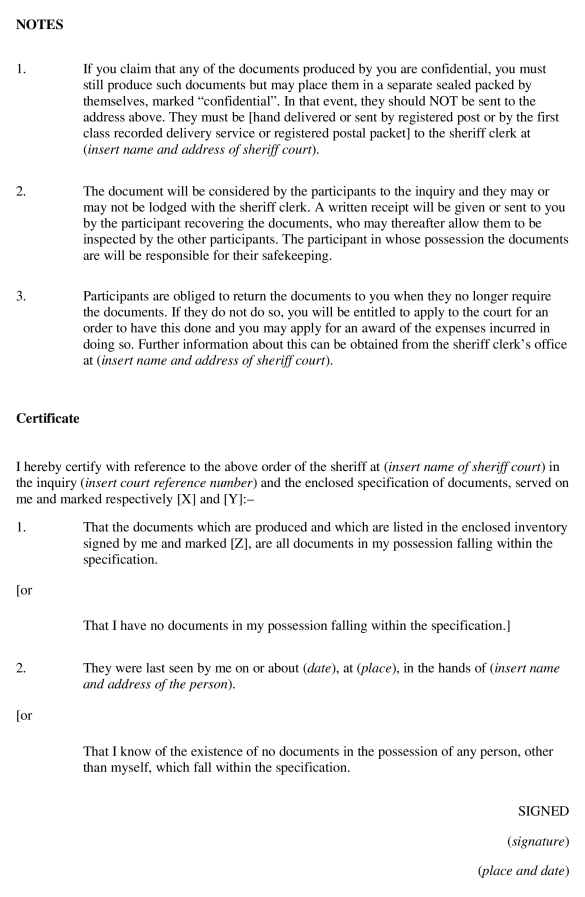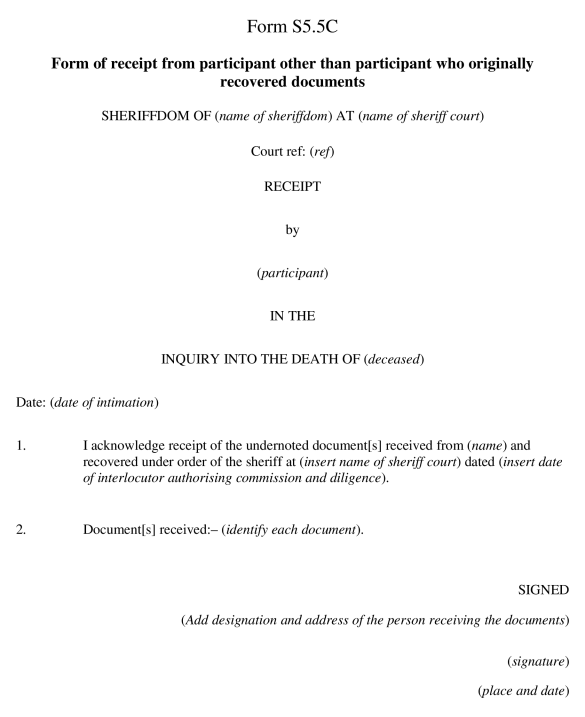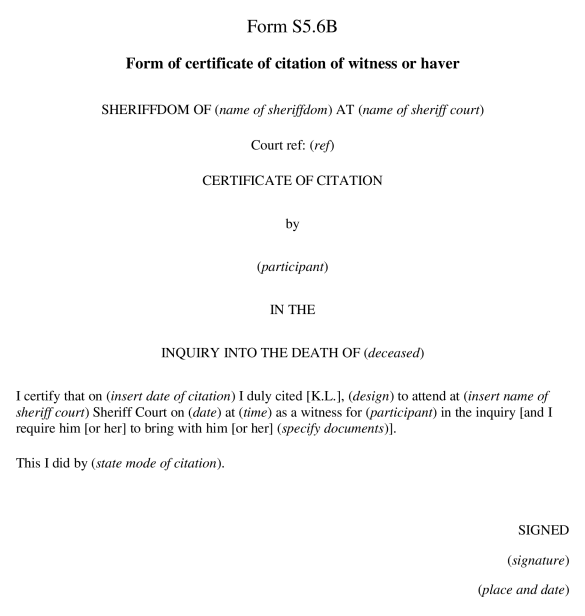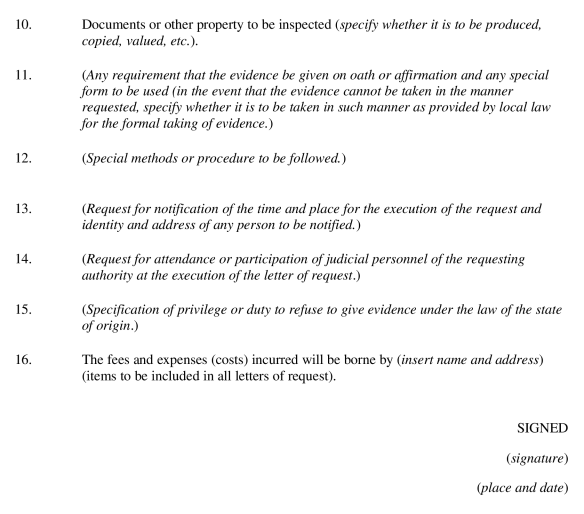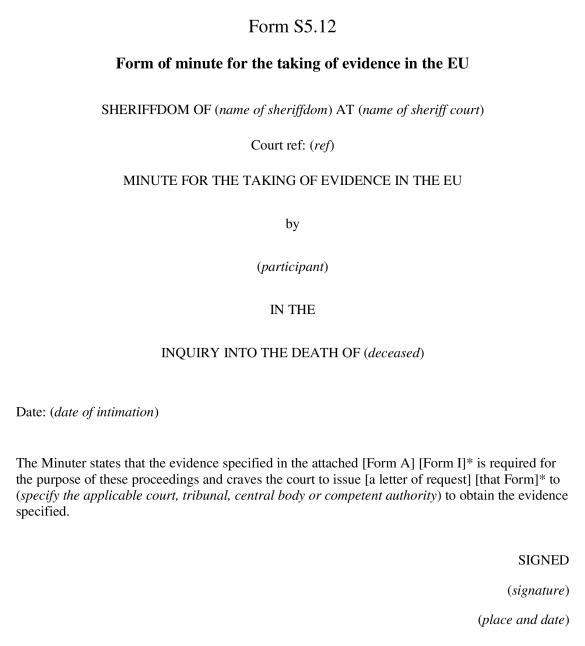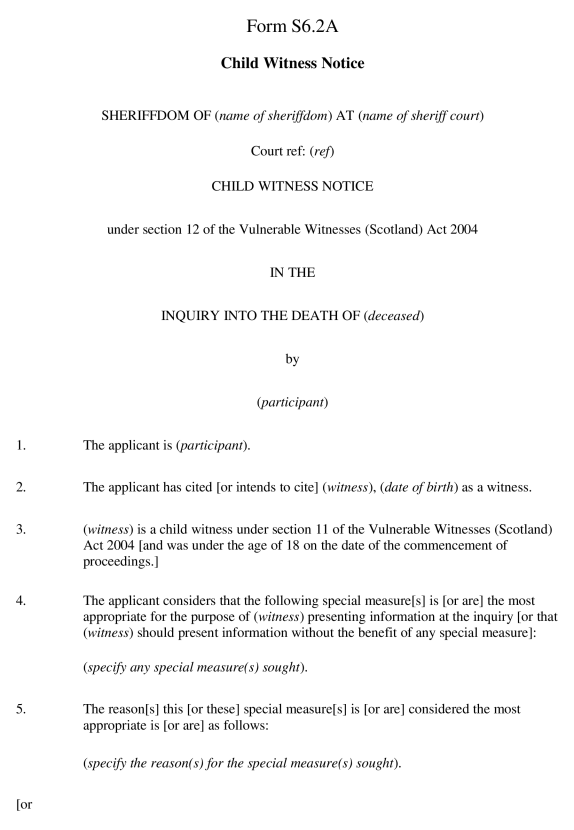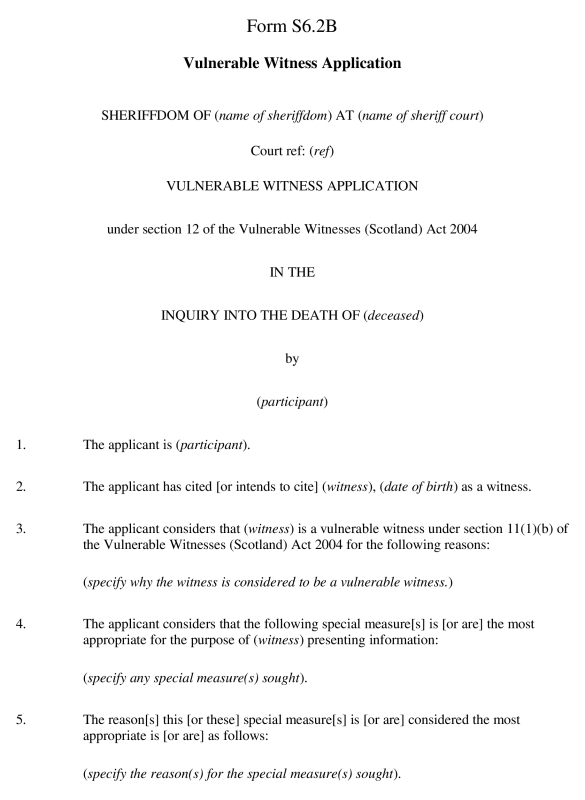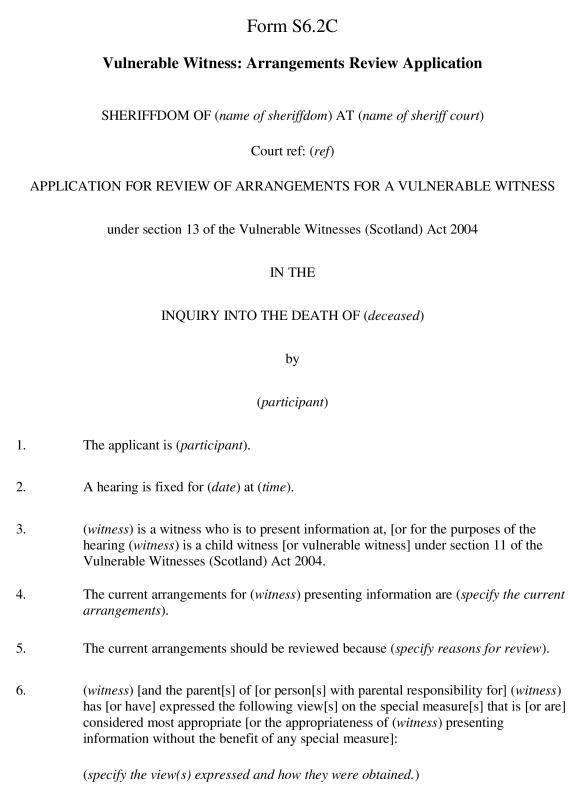Scottish Statutory Instruments
2017 No. 103
Sheriff Court
Act of Sederunt (Fatal Accident Inquiry Rules) 2017
Made
31st March 2017
Laid before the Scottish Parliament
4th April 2017
Coming into force
15th June 2017
In accordance with section 4 of the Scottish Civil Justice Council and Criminal Legal Assistance Act 2013(1), the Court of Session has approved draft rules submitted to it by the Scottish Civil Justice Council with such modifications as it thinks appropriate.
The Court of Session therefore makes this Act of Sederunt under the powers conferred by section 36(1) of the Inquiries into Fatal Accidents and Sudden Deaths etc. (Scotland) Act 2016(2), paragraph 1A of schedule 2 of the European Communities Act 1972(3) and all other powers enabling it to do so.
This Act of Sederunt makes provision for a purpose mentioned in section 2(2) of the European Communities Act 1972(4) and it appears to the Court of Session that it is expedient for the references in this Act of Sederunt to Council Regulation (EC) No. 1206/2001 of 28th May 2001 on cooperation between the courts of the Member States in the taking of evidence in civil or commercial matters(5) and to Regulation (EC) No. 1393/2007 of the European Parliament and of the Council of 13th November 2007 on the service in the Member States of judicial and extrajudicial documents in civil or commercial matters (service of documents), and repealing Council Regulation (EC) No. 1348/2000(6), to be construed as references to those instruments as amended from time to time.
PART 1CITATION, COMMENCEMENT AND INTERPRETATION, ETC.
Citation and commencement, etc.
1.1.—(1) This Act of Sederunt may be cited as the Act of Sederunt (Fatal Accident Inquiry Rules) 2017.
(2) It comes into force on 15th June 2017.
(3) A certified copy is to be inserted in the Books of Sederunt.
Interpretation
1.2.—(1) In these Rules—
“apply” means apply in accordance with schedule 1, and related expressions are to be construed accordingly;
“the Council Regulation” means Council Regulation (EC) No. 1206/2001 of 28th May 2001 on cooperation between the courts of the Member States in the taking of evidence in civil or commercial matters, as amended from time to time;
“the deceased” means the person whose death the inquiry is concerned with;
“first notice” means notice that an inquiry is to be held under section 15(1);
“first order” means the order of the sheriff made under rule 3.2(1);
“the inquiry principles” means the principles in rule 2.2;
“intimate” means intimate in accordance with schedule 2, and related expressions are to be construed accordingly;
“participants” includes the procurator fiscal;
“the purpose of the inquiry” means the purpose set out in section 1(3) and (4);
“SCTS” means the Scottish Courts and Tribunals Service; and
“witness statement” has the meaning given by rule 4.13(2).
(2) In these Rules, references to a section are to that section of the Inquires into Fatal Accidents and Sudden Deaths etc. (Scotland) Act 2016.
Periods of time
1.3. If any period of time specified in these Rules expires on a Saturday, Sunday or public or court holiday, it is extended to expire on the next day that the sheriff clerk’s office is open for civil business.
Forms
1.4.—(1) A reference in these Rules to a form is a reference to that form in schedule 3.
(2) Those forms may be varied where the circumstances require it.
Miscellaneous and general matters
1.5. Schedule 4 makes provision about—
(a)lodging;
(b)live links;
(c)reporting restrictions;
(d)the style of oath and affirmation;
(e)interventions; and
(f)lay representation and support.
PART 2OVERVIEW
The structure of an inquiry
2.1. An inquiry proceeds as follows—
(a)the procurator fiscal begins the procedure by sending the sheriff first notice of the inquiry (see rule 3.1);
(b)the sheriff makes a first order and other participants become involved in the inquiry (see rules 3.2 to 3.5);
(c)the sheriff normally holds one or more preliminary hearings, to make sure that the inquiry is ready to start (see rules 3.6 to 3.8);
(d)the sheriff may make orders about the presentation of information and the participants will notify each other and the sheriff of the information they intend to present at the inquiry (see Part 4);
(e)the inquiry is held, with the sheriff presiding (see Part 5); and
(f)the sheriff produces a determination (see Part 6).
The inquiry principles
2.2.—(1) An inquiry is inquisitorial not adversarial.
(2) An inquiry is to be progressed expeditiously and efficiently, with as few delays as possible.
(3) Taking into account the nature and complexity of the inquiry—
(a)the procedure at an inquiry is to be as flexible as appropriate; and
(b)the manner in which information is presented is to be as efficient as possible.
(4) All participants are to be able to participate effectively in furthering the purpose of the inquiry.
Taking into account the inquiry principles
2.3.—(1) The sheriff must take into account the inquiry principles when—
(a)interpreting these Rules; and
(b)making any orders.
(2) Participants and representatives must respect the inquiry principles by—
(a)taking into account the inquiry principles when seeking an order; and
(b)assisting the sheriff with the duty in paragraph (1).
Representation and support
2.4.—(1) A participant other than the procurator fiscal may—
(a)appear on the participant’s own behalf;
(b)be represented by a solicitor, an advocate, or both;
(c)with the permission of the sheriff, be represented by a lay representative;
(d)with the permission of the sheriff, be supported by a lay supporter.
(2) Where a solicitor or lay representative withdraws from acting on behalf of a participant, the solicitor or lay representative must lodge a notice of withdrawal.
Judicial continuity
2.5. Where possible, the same sheriff is to—
(a)consider the first notice and make the first order;
(b)preside at all preliminary hearings; and
(c)preside at the inquiry.
The inquiry management powers
2.6.—(1) The sheriff may make any order necessary to further the purpose of an inquiry, including—
(a)an order made to assist the sheriff to identify which issues are in dispute, such as an order—
(i)fixing a hearing and specifying a purpose for that hearing;
(ii)requiring participants to disclose the existence and nature of any information they hold relating to the inquiry;
(iii)requiring participants to lodge particular documents or other items, or to lead particular witnesses;
(iv)restricting the documents or other items which a participant may present, or the witnesses a participant may lead;
(v)granting authority to recover documents or other items relating to the inquiry;
(b)an order made to allow the sheriff to manage time efficiently, such as an order—
(i)imposing a time limit on any step to be taken by a participant;
(ii)varying a deadline or time limit set out in these Rules;
(c)dealing with a participant’s non-compliance with a rule or order, such as an order—
(i)requiring that participant to take a step as a consequence of not complying with a rule or order;
(ii)relieving the participant from the consequences of not complying with a rule or order;
(iii)imposing conditions on any relief from non-compliance.
(2) The sheriff may make orders—
(a)of the sheriff’s own accord; or
(b)on the application of a participant.
PART 3PRE-INQUIRY PROCEDURE
First notice
3.1.—(1) First notice is to be given in Form 3.1.
(2) First notice must set out—
(a)the information required by section 15(2)(a) (that is, a brief account of the circumstances of the death, so far as known to the procurator fiscal);
(b)the identity of the deceased;
(c)any issues identified by the procurator fiscal which it is anticipated the inquiry should address;
(d)whether the procurator fiscal considers that a preliminary hearing is unnecessary and, if so, the reasons for that view;
(e)whether the inquiry is mandatory or discretionary and—
(i)if mandatory, the category of mandatory inquiry;
(ii)if discretionary, whether the Lord Advocate considers that the death fell within section 4(1)(a)(i) or (ii);
(f)in the case of a discretionary inquiry under section 6 (inquiries into deaths occurring abroad: general), which condition in section 6(3)(a) is met;
(g)in the case of a discretionary inquiry under section 7 (inquiries into deaths occurring abroad: service personnel) that the conditions in section 7(1)(c) are met; and
(h)the identity of any person who the procurator fiscal considers might have an interest in the inquiry.
First order
3.2.—(1) The sheriff must make an order (a “first order”) under section 15(3) (initiating the inquiry) within 14 days of receiving first notice.
(2) The sheriff may order the procurator fiscal to appear in chambers to discuss the first order.
(3) If the sheriff orders that a preliminary hearing is to be held, it must be ordered to take place within 56 days after the date of the first order.
(4) If the sheriff orders that a preliminary hearing is not to be held, the inquiry must be ordered to take place within 56 days after the date of the first order.
Notice of the inquiry
3.3.—(1) Notice under section 17(1) in relation to an inquiry is to be given in Form 3.3A.
(2) Notice must be given at least 42 days before—
(a)the preliminary hearing; or
(b)if the sheriff has not ordered a preliminary hearing, the date fixed for the start of the inquiry.
(3) In addition to the persons mentioned in section 17(2)(a), notice must be given to—
(a)a person named in the first order as a person the sheriff is satisfied has an interest in the inquiry;
(b)in a category of death listed in column 1 of the following table, the person specified in column 2.
| Column 1 | Column 2 |
|---|---|
| Circumstances of death | Specified person |
| a death within section 2(3)(b) of the Act (death as a result of an accident which occurred while the person was acting in the course of the person’s employment or occupation) | The Health and Safety Executive |
| a death within section 2(4)(b) (death of a child required to be kept or detained in secure accommodation) | The local authority or other provider of secure accommodation in whose care the child died, the Scottish Ministers and Social Care and Social Work Improvement Scotland |
| death within section 2(5)(a) (death of a person required to be imprisoned or detained in a penal institution) | The Scottish Ministers or the Chief Constable of the relevant police force, respectively |
| death within section 2(5)(b) (death in police custody) | The Chief Constable of the relevant police force |
| a death within section 2(5)(c) (death in custody on court premises) | The Scottish Courts and Tribunals Service |
| a death within section 2(5)(d) (death of a person detained in service custody premises) | The Secretary of State |
| a death within section 5 (certain deaths and accidents to be treated as occurring in Scotland) | The Secretary of State |
| a death within section 6 (inquiries into deaths occurring abroad: general) | The Secretary of State |
| a death within section 7 (inquiries into deaths occurring abroad: service personnel) | The Secretary of State |
| a death within article 6 of the Inquiries into Fatal Accidents and Sudden Deaths etc. (Scotland) Act 2016 (Consequential Provisions and Modifications) Order 2016(7) (death in Scotland of service personnel) | The Secretary of State. |
(4) A person given notice under this rule who intends to participate must indicate that intention by lodging a notification in Form 3.3B at least 14 days before the start of the inquiry.
Public notice of the inquiry
3.4.—(1) Public notice under section 17(3) is to be given in Form 3.4.
(2) Notice is to be given by intimating it to SCTS at least 42 days before—
(a)the preliminary hearing; or
(b)if the sheriff has not ordered a preliminary hearing, the date fixed for the start of the inquiry.
(3) SCTS must publish the notice on its website when it is received.
(4) In addition to publication under paragraph (3), the sheriff may order public notice to be given by other methods.
Other participation
3.5.—(1) A person who is not given notice under section 17(1) but who wishes to participate in an inquiry may apply to the sheriff to participate.
(2) That application must—
(a)set out why that person’s participation would further the purpose of the inquiry; and
(b)be made at least 14 days before the start of the inquiry.
Preliminary hearings
Purpose of preliminary hearings
3.6.—(1) The purpose of a preliminary hearing is to—
(a)ensure that the purpose of the inquiry is achieved when the inquiry takes place;
(b)consider the scope of the inquiry and identify the issues which are in dispute; and
(c)consider the information likely to be presented at the inquiry and the manner in which it should be presented.
(2) The sheriff may order as many preliminary hearings to take place as is necessary to achieve that purpose.
Before the first preliminary hearing
3.7. Unless the sheriff orders otherwise, at least 7 days before the first preliminary hearing each participant must lodge a brief note setting out, where known—
(a)the matters considered likely to be in dispute at the inquiry;
(b)a list of any productions which it is considered might be used at the inquiry and a note of their relevance to the purpose of the inquiry;
(c)a list of persons whom it is considered might be led as witnesses at the inquiry and a note of their relevance to the purpose of the inquiry; and
(d)the matters which the sheriff might be invited to address in the sheriff’s determination.
Procedure
3.8.—(1) The procedure at a preliminary hearing is to be as ordered by the sheriff.
(2) At the preliminary hearing (or by the last preliminary hearing) the sheriff must—
(a)consider whether there are any further persons who the sheriff is satisfied have an interest in the inquiry under section 11(1)(e);
(b)establish who is to participate in the inquiry;
(c)establish the nature and complexity of the inquiry;
(d)consider the likely length, timetable and date for the start of the inquiry;
(e)establish any matters which are likely to be in dispute at the inquiry;
(f)establish the state of preparedness of the participants;
(g)consider how information should be presented to the inquiry including—
(i)how information will be gathered (see rule 4.4);
(ii)the timetable for lodging productions and witness lists (see rules 4.6 and 4.7);
(iii)the arrangements for any vulnerable witnesses (see rule 4.9);
(iv)how participants are progressing with discharging their duty to agree information (see rule 4.11);
(v)whether notices to admit information are required (see rule 4.12);
(vi)whether any witness statements will be required (see rule 4.13);
(vii)whether any video recordings will be required (see rule 4.14);
(viii)how any expert witnesses should present information (see rules 4.15 to 4.19); and
(ix)what other technology (for example, live links) will be used;
(h)consider any other preliminary matter raised by a participant; and
(i)identify any legal aid applications which have been, or require to be, made or renewed by participants.
(3) At the conclusion of a preliminary hearing the sheriff must—
(a)fix a date for another preliminary hearing; or
(b)fix a date for the start of the inquiry.
(4) Where the sheriff fixes a date for another preliminary hearing, the sheriff must specify—
(a)the reason for fixing another preliminary hearing; and
(b)the matters which will be considered at that preliminary hearing.
(5) Where the sheriff fixes a date for the start of the inquiry, SCTS must publish a notice of that date on its website.
PART 4INFORMATION
The law of evidence
4.1.—(1) Any rule of law or enactment that prevents evidence being led on grounds of inadmissibility does not apply in an inquiry.
(2) Where a person would be entitled to withhold information on the grounds of legal professional privilege, nothing in this rule affects that person’s ability to refuse to produce that document or present it at an inquiry.
(3) Any rule of law that restricts the manner in which evidence must be presented does not apply in an inquiry.
(4) Subject to any orders made by the sheriff—
(a)information may be presented to the inquiry in any manner; and
(b)the sheriff may reach conclusions based on that information.
The information management powers
4.2. The sheriff may make orders about the manner in which information is presented to the inquiry or about how the sheriff will reach conclusions, such as an order—
(a)restricting the information presented to particular issues or particular sources;
(b)determining the manner in which information is to be presented, whether by oral presentation, written statement, the production of documents or other items, live link, video recording, or otherwise;
(c)determining the manner in which the sheriff is to reach conclusions.
Witnesses and productions
Citation of witnesses
4.3.—(1) The order which fixes a date for the start of the inquiry is warrant for the citation of witnesses by participants.
(2) A participant only needs to cite a witness to appear at the inquiry if the participant is otherwise unable to ensure that witness’s appearance.
(3) A participant may cite a witness by—
(a)intimating a citation in Form 4.1A on that witness at least 7 days before the date fixed for the start of the inquiry; and
(b)lodging a certificate of citation in Form 4.1B.
(4) Where a properly cited witness fails to answer that citation, the sheriff may—
(a)grant warrant for the apprehension of the witness and for bringing the witness to the inquiry;
(b)order the witness to make a payment to a participant.
(5) A solicitor who cites a witness is liable for that witness’s fees and expenses.
(6) Where a participant is not represented by a solicitor, that participant must—
(a)apply to the sheriff to fix caution in such sum as the sheriff considers reasonable having regard to the number of witnesses the participant proposes to cite and the period for which they may be required to attend the inquiry; and
(b)before citing a witness, find caution for such expenses as can reasonably be anticipated to be incurred by the witness in answering the citation.
(7) Where a participant who is not represented by a solicitor does not intend to cite all the witnesses referred to in the application to fix caution, that participant may apply to the sheriff for variation of the amount of caution.
Gathering information
4.4. Once the sheriff has made the first order, a participant may gather information for use in an inquiry in accordance with schedule 5.
Oath and affirmation
4.5. The sheriff may administer either the oath or affirmation to a witness.
Lodging productions
4.6.—(1) All productions which a participant intends to present to an inquiry must be lodged by the date ordered by the sheriff.
(2) A participant may only present a production which has not been lodged with the leave of the sheriff.
(3) A copy of every documentary production must be lodged for the use of the sheriff no later than 7 days before the start of the inquiry.
(4) Any productions which have been borrowed must be returned no later than 2 days before the start of the inquiry.
Witness lists
4.7.—(1) A list of witnesses must be lodged by the date ordered by the sheriff.
(2) A participant may only present a witness who is not listed with the leave of the sheriff.
Recording of the inquiry
4.8.—(1) The information presented at the inquiry is to be recorded by any means ordered by the sheriff.
(2) Under section 27(3) (transcript of evidence at the inquiry), SCTS must give a person a copy of any transcript if that person makes the request within 28 days following the date of the sheriff’s determination.
(3) The transcript will be provided to that person upon payment of a fee of—
(a)where a transcript has to be made, £1.61 for each minute that has to be transcribed; or
(b)where a transcript has already been made—
(i)£6.00 for a photocopy of a transcript up to 10 pages; and
(ii)£0.50 for each page in excess of 10 pages.
(4) Where more than one person makes a request within 28 days following the date of the sheriff’s determination, the sheriff may make an order about how the fee payable under paragraph (2) is to be divided between them.
Vulnerable witnesses
4.9. Schedule 6 makes provision about vulnerable witnesses.
Agreeing information
Joint minutes of agreement
4.10.—(1) It is not necessary for the participants to present information to the inquiry concerning—
(a)a fact agreed by all participants;
(b)a production, the terms and application of which are agreed by all participants.
(2) An agreement is made by lodging a joint minute of agreement.
(3) A joint minute of agreement must be signed by each participant or by that participant’s representative.
(4) Where any participant is not legally represented, a joint minute of agreement must be approved by the sheriff.
The duty to agree information
4.11.—(1) Before the start of the inquiry, each participant must identify information which—
(a)that participant would, apart from this rule, present at the inquiry; and
(b)is considered by that participant unlikely to be disputed by other participants.
(2) The participants must take all reasonable steps to agree such information.
(3) In particular, the participants must take all reasonable steps to agree the following—
(a)the name, age, address and occupation of the deceased;
(b)the location, date and time of the deceased’s death;
(c)the circumstances in which the death was discovered;
(d)the identity of any person who witnessed the accident or discovered the deceased’s body;
(e)the name of the doctor who pronounced the death of the deceased;
(f)in the case of a death falling within section 2(3) (death in the course of employment in Scotland)—
(i)the name and address of the deceased’s employer;
(ii)the length of period of employment;
(iii)the nature of employment; and
(iv)the deceased’s employment duties at the time of death;
(g)in the case of a death falling within section 2(4)(a) (death in legal custody)—
(i)the offence committed, date of conviction and time spent in custody;
(ii)the offence alleged to have been committed, the date and place of remand and the reasons for that remand; or
(iii)the reasons for the deceased being in legal custody;
(h)in the case of a death within article 6 of the Inquiries into Fatal Accidents and Sudden Deaths etc. (Scotland) Act 2016 (Consequential Provisions and Modifications) Order 2016(8) (death in Scotland of service personnel)—
(i)the length of period of service;
(ii)the nature of service; and
(iii)the deceased’s service duties at the time of death;
(i)any post-mortem report; and
(j)any toxicology report.
Notices to admit information
4.12.—(1) This rule applies where the sheriff orders that notices to admit information must be intimated by a particular date.
(2) A participant (referred to in this rule as “the first participant”) may prepare a notice to admit information in Form 4.12A.
(3) The notice must set out facts or productions which—
(a)the first participant would, apart from this rule, seek to present at the inquiry; and
(b)are considered by the first participant unlikely to be disputed or the terms and application of which are unlikely to be disputed by other participants.
(4) The first participant must intimate a copy of the notice, along with a copy of any production referred to in the notice, to all other participants by the date ordered by the sheriff.
(5) Each other participant may object to any fact or production set out in the notice by intimating to the first participant an objection in Form 4.12B within 7 days after the date on which the notice was intimated.
(6) It is not necessary for the participants to present information to the inquiry concerning a fact or production which no other participant objects to.
(7) Each other participant may present information relevant to, or in explanation of, a fact or document set out in a notice.
(8) On the application of any other participant, the sheriff may, if satisfied that there are circumstances justifying it, make an order that paragraph (6) does not apply to certain facts or productions in a notice.
Witness statements
4.13.—(1) This rule applies where the sheriff orders that the witness statement of a witness must be lodged by a particular date.
(2) A “witness statement” is a written statement—
(a)containing information which a person could present orally at an inquiry; and
(b)signed by that person.
(3) With the permission of the sheriff, the participant relying on the witness statement may, at the inquiry—
(a)ask questions of the witness which introduce, clarify or supplement the witness statement;
(b)ask questions of the witness which relate to new matters which have arisen since the witness statement was lodged.
(4) The witness statement must be made available for inspection by the public during the inquiry.
(5) Other participants may question the witness.
Video recordings
4.14.—(1) This rule applies where the sheriff orders that a witness is to present information at the inquiry by video recording, whether the video recording has already been made or not.
(2) The video recording must be lodged by a date ordered by the sheriff.
(3) The sheriff must make an order about—
(a)the format of the video recording and how it is to be played at the inquiry;
(b)if the video recording has not already been made, the right of participants to participate in its production;
(c)whether the witness also needs to attend the inquiry, to provide further information.
Expert witnesses
Instructing expert witnesses
4.15.—(1) An expert witness may only present information about matters which are necessary to further the purpose of the inquiry.
(2) A participant who has decided to instruct an expert witness must, as early as possible, lodge a note setting out—
(a)the identity of the witness to be instructed, if known;
(b)why the information to be presented by that witness is necessary to further the purpose of the inquiry;
(c)the broad terms of the instruction; and
(d)the expected completion date of any report.
Information presented by expert witnesses
4.16.—(1) This rule applies where the sheriff orders that an expert witness is to present information at the inquiry by—
(a)witness statement (see rule 4.13); or
(b)video recording (see rule 4.14).
(2) The witness statement of an expert witness—
(a)may consist of that witness’s report; or
(b)must incorporate that witness’s report.
Minute of questions
4.17.—(1) This rule applies where a participant has lodged a witness statement or video recording of an expert witness.
(2) Other participants may lodge a minute of questions to be put to that expert witness.
(3) Each participant may only lodge one minute of questions and the minute of questions must be lodged within 14 days of the witness statement or video recording being lodged.
(4) The sheriff may approve the minute, with such modifications as the sheriff considers appropriate, and order answers to be lodged by a particular date.
Single expert witnesses
4.18.—(1) The sheriff may order information to be presented on a particular matter by a single expert witness.
(2) Where the sheriff makes such an order, participants must make reasonable efforts to agree joint instructions for the expert witness.
(3) Where participants cannot agree joint instructions—
(a)they must send a joint instruction about any matters they can agree;
(b)they must lodge separate instructions about other matters; and
(c)the sheriff must approve the terms of those separate instructions before they are sent to the single expert witness.
(4) Where participants cannot agree on the identity of a single expert witness, the sheriff may—
(a)select an expert from a list prepared by the participants; or
(b)order how an expert is to be selected.
(5) Unless the sheriff orders otherwise, the cost of instructing the single expert witness is to be shared equally between the participants.
Concurrent presentation of expert witnesses
4.19.—(1) The sheriff may order expert witnesses to present information concurrently.
(2) Where the sheriff makes such an order—
(a)the participants must jointly prepare a note for the sheriff, setting out the areas of agreement and disagreement between the expert witnesses; and
(b)that note must be lodged at least 7 days before the start of the inquiry.
(3) At the hearing at which information is presented by concurrent presentation—
(a)all expert witnesses will present information at the same time; and
(b)the sheriff may direct how information is to be presented by the expert witnesses, including by the sheriff questioning the witnesses directly, inviting the witnesses to discuss a particular matter between them, or allowing questioning by participants where necessary.
PART 5THE INQUIRY
Procedure
5.1. The procedure at an inquiry is to be as ordered by the sheriff.
PART 6THE SHERIFF’S DETERMINATION
Form of determination
6.1. A determination under section 26 is to be in Form 6.1.
Form of response
6.2. A response under section 28(1)(a) (compliance with sheriff’s recommendations: responses) is to be in Form 6.2.
Form of notice
6.3. A notice under section 28(5) (compliance with sheriff’s recommendations: notice where response given) is to be in Form 6.3.
PART 7FURTHER INQUIRY PROCEEDINGS
Form of notice
7.1.—(1) Notice under section 32 that further inquiry proceedings are to be held is to be given in Form 7.1.
(2) The notice must—
(a)set out the identity of the deceased;
(b)have appended to it a copy of the determination in the inquiry into the death of the deceased; and
(c)contain the information required by section 32(2)(a) and (b).
CJM SUTHERLAND
Lord President
Edinburgh
I.P.D.
31st March 2017
Rule 1.2(1)
SCHEDULE 1APPLICATIONS
Interpretation
1. In this schedule—
“lodging participant” means the person lodging the application;
“receiving participant” means a participant receiving the intimation of the application from the lodging participant.
Making of applications
2. An application may be made—
(a)orally; or
(b)in writing, in accordance with paragraph 3.
Written applications
3.—(1) An application in writing is made by lodging it.
(2) An application in writing must set out the grounds on which it is made.
Intimation of applications in writing
4.—(1) The lodging participant must give intimation of an intention to lodge the application, and of the terms of the application, to every other participant in Form S1.4.
(2) That intimation must be accompanied by a copy of any document referred to in the application.
Opposition to applications in writing
5.—(1) A receiving participant may oppose an application by lodging a notice of opposition in Form S1.5.
(2) Any notice of opposition must be lodged within 7 days after the date of intimation of the application.
(3) The sheriff may, on the request of a participant—
(a)vary the period of 7 days mentioned in subparagraph (2); or
(b)dispense with intimation on any participant.
(4) A request mentioned in subparagraph (3) must—
(a)be included in the application; and
(b)give reasons for varying the period or dispensing with intimation, as the case may be.
(5) The sheriff may allow a notice of opposition to be lodged late, on cause shown.
Consent to applications in writing
6. A receiving participant may consent to an application by lodging a notice to that effect.
Lodging of applications in writing
7.—(1) The application must be lodged by the lodging participant within 5 days after the date of intimation of the application, unless subparagraph (3) applies.
(2) The lodging participant must also lodge—
(a)a certificate of intimation in Form S1.7; and
(b)so far as practicable, any document referred to in the application that has not already been lodged.
(3) Where the sheriff varies the period for lodging a notice of opposition to a period of 5 days or less, the application must be lodged no later than the day on which that period expires.
Joint applications in writing
8.—(1) A joint application by all participants need not be intimated.
(2) A joint application may be lodged by any of the participants.
Hearing of opposed applications in writing
9.—(1) Where a notice of opposition is lodged, the application is to be heard by the sheriff on the first suitable court day after lodging.
(2) The sheriff clerk must intimate the date and time of the hearing to the participants.
Rule 1.2(1)
SCHEDULE 2INTIMATION
PART 1Intimation within Scotland
Interpretation
1. In this schedule—
“first class post” means a postal service which seeks to deliver documents or other things by post no later than the next working day in all or the majority of cases;
“intimating participant” means any participant who has to give intimation in accordance with paragraph 2;
“receiving participant” means any participant to whom intimation is to be given; and
“recorded delivery” means a postal service which provides for the delivery of the document or other thing by post to be recorded.
Intimation
2.—(1) Unless the sheriff orders otherwise, intimation is to be given to every other participant where any provision in these Rules requires a participant to—
(a)intimate something; or
(b)lodge something.
(2) The sheriff clerk must intimate an order of the sheriff to every participant when the sheriff makes an order other than at a hearing where all participants are present or represented.
Methods of intimation
3.—(1) Intimation may be given to a receiving participant by any of the methods specified in paragraphs 4 and 5.
(2) Where the receiving participant is represented by a solicitor, intimation may also be given by any of the methods specified in paragraph 6.
(3) Where the receiving participant is furth of Scotland, intimation must be given in accordance with Part 2 of this schedule.
Methods of intimation: intimation by recorded delivery
4. An intimating participant may give intimation by recorded delivery to the receiving participant.
Methods of intimation: intimation by sheriff officer
5.—(1) A sheriff officer may give intimation on behalf of an intimating participant by—
(a)delivering the intimation personally to the receiving participant; or
(b)leaving the intimation in the hands of—
(i)a resident at the receiving participant’s dwelling place; or
(ii)an employee, agent or representative at the receiving participant’s place of business.
(2) Where a sheriff officer has been unsuccessful in intimation in accordance with subparagraph (1), the sheriff officer may give intimation by—
(a)depositing it in the receiving participant’s dwelling place or place of business; or
(b)leaving it at the receiving participant’s dwelling place or place of business in such a way that it is likely to come to the attention of that participant.
Additional methods of intimation where receiving participant represented by solicitor
6.—(1) An intimating participant may give intimation to the solicitor for the receiving participant by—
(a)delivering it personally to the solicitor;
(b)delivering it to a document exchange of which the solicitor is a member;
(c)first class post;
(d)fax; or
(e)email.
(2) Where intimation is given by the method in subparagraph (1)(a), (d) or (e) not later than 1700 hours on any day, the date of intimation is that day.
(3) Where intimation is given by the method in—
(a)subparagraph (1)(b) or (c); or
(b)subparagraph (1)(a), (d) or (e) after 1700 hours on any day,
the date of intimation is the next day.
Form of certificate of intimation
7. A certificate of intimation is to be in S2.7.
PART 2Intimation furth of Scotland
Interpretation of this Part
8. In this Part—
“consular service” is to be construed in accordance with paragraph 15;
“EU member State” means a State which is a member of the European Union, within the meaning of Part II of Schedule 1 of the European Communities Act 1972(9);
“Hague Convention country” means a country in respect of which the Convention of 15th November 1965 on the Service Abroad of Judicial and Extrajudicial Documents in Civil or Commercial Matters is in force, other than an EU member State(10);
“personal service” is to be construed in accordance with paragraph 16;
“postal service” is to be construed in accordance with paragraph 17; and
“Service Regulation” means Regulation (EC) No. 1393/2007 of the European Parliament and of the Council of 13th November 2007 on the service in the Member States of judicial and extrajudicial documents in civil or commercial matters (service of documents), and repealing Council Regulation (EC) No. 1348/2000(11), as amended from time to time.
Intimation furth of Scotland
9.—(1) Intimation of a document furth of Scotland is to be effected in accordance with this paragraph.
(2) If the person’s known residence or place of business is in England and Wales, Northern Ireland, the Isle of Man or the Channel Islands, see paragraph 10.
(3) If the person’s known residence or place of business is in an EU member State (including Denmark), see paragraph 11.
(4) If the person’s known residence or place of business is in a Hague Convention country (other than an EU member State), see paragraph 12.
(5) If the person’s known residence or place of business is in a country with which the United Kingdom has a convention about how to serve court documents (such as Algeria, Libya and the United Arab Emirates), see paragraph 13.
(6) If none of the above applies, see paragraph 14.
Service in England and Wales etc.
10.—(1) A document may be intimated in England and Wales, Northern Ireland, the Isle of Man or the Channel Islands by—
(a)postal service; or
(b)personal service.
(2) Personal service may be effected by a person who is authorised to do so under the domestic law of the place where the document is to be served.
Service in an EU member State
11.—(1) A document may be intimated in an EU member State (including Denmark) under the Service Regulation by—
(a)postal service;
(b)service by transmitting agency;
(c)direct service, where the law of the member State permits it; or
(d)consular service.
(2) Service by transmitting agency may be effected by sending the document to a messenger-at-arms and instructing them to arrange for it to be served.
(3) Direct service may be effected by sending the document to a person who is entitled to serve court documents in that member State and asking them to arrange for it to be served.
(4) Where service is to be effected by transmitting agency, the participant must give the messenger-at-arms a translation of the document into a language which the recipient understands or an official language of the member State where the document is to be served.
Service in a Hague Convention country
12.—(1) A document may be intimated in a Hague Convention country (other than an EU member State) by—
(a)postal service, where the law of the country permits it;
(b)service via central authority;
(c)consular service; or
(d)service by competent person, where the law of the country permits it.
(2) Service via central authority may be effected by sending the document to the Scottish Ministers and asking them to arrange for it to be served.
(3) Service by competent person may be effected by sending the document to a person who is entitled to serve court documents in that country and asking them to arrange for it to be served.
(4) Any document must be accompanied by a translation into an official language of the country where it is to be served, unless English is an official language of that country.
Service in a country with which the United Kingdom has a convention about how to serve court documents
13. A document may be intimated in a country with which the United Kingdom has a convention about how to serve court documents by any method that is permitted by the convention.
Service in any other country
14.—(1) Where none of paragraphs 10 to 13 apply, a document may be intimated by—
(a)postal service; or
(b)personal service.
(2) Where intimation is effected by personal service, the participant executing service must lodge a certificate stating that the method of service employed is in accordance with the law of the country where service was executed.
(3) That certificate is to be given by a person who—
(a)practises or has practised law in that country; or
(b)is an accredited representative of that country’s government, conversant with the law of that country.
Consular service
15.—(1) Consular service is service by a British consular authority.
(2) Consular service may be effected only if—
(a)the law of the State where the document is to be served permits it; or
(b)the document is being served on a British national.
(3) Consular service may be effected by sending the document to the Secretary of State for Foreign and Commonwealth Affairs and asking the Secretary of State to arrange for it to be served by a British consular authority.
Personal service
16.—(1) Personal service is service using the rules for personal service under the domestic law of the place where the document is to be served.
(2) Personal service may be effected by a person who is authorised to do so under the domestic law of the place where the document is to be served.
Postal service
17.—(1) Postal service is service by posting the document to the person’s home or business address using a postal service which records delivery.
(2) Postal service may be effected by a solicitor or a sheriff officer.
(3) Where postal service is used, the envelope containing the document must have the following label printed or written on it—
| “THIS ENVELOPE CONTAINS A (name of document) FROM (name of sheriff court), SCOTLAND |
| IF DELIVERY CANNOT BE MADE, THE LETTER MUST BE RETURNED TO THE SHERIFF CLERK AT |
| (full address of sheriff court)”. |
(4) That label must be translated into an official language of the country where the document is to be served, unless English is an official language of that country.
Certification of translations
18.—(1) This paragraph applies where this schedule requires a document to be translated into a language other than English.
(2) The participant executing service must lodge a certificate stating that the translation is correct.
(3) That certificate—
(a)is to be given by the person who made the translation; and
(b)must include the full name, address and qualifications of the translator.
Rule 1.4
SCHEDULE 3FORMS
Rule 1.5
SCHEDULE 4MISCELLANEOUS AND GENERAL MATTERS
Lodging
1.—(1) Where these Rules require something to be lodged or the sheriff orders something to be lodged, it must be lodged with the sheriff clerk.
(2) Something may be lodged by—
(a)delivering it personally to the sheriff clerk’s office;
(b)delivering it to a document exchange of which the sheriff clerk is a member;
(c)delivering it using a postal service which seeks to deliver documents or other things by post no later than the next working day in all or the majority of cases;
(d)fax; or
(e)another method ordered by the sheriff.
Live links
2.—(1) In this rule—
“live link” means—
a live television link; or
where the sheriff gives permission, an alternative arrangement; and
“submission” means any oral submission which would otherwise be made to the sheriff by a participant or that participant’s representative, including an oral submission in support of an application.
(2) A participant may apply to the sheriff to use a live link to make a submission or to present information.
(3) Where a participant seeks to use an alternative arrangement, the application must specify the proposed arrangement.
(4) The sheriff must not grant an application to use an alternative arrangement unless the person using the live link is able to—
(a)be heard in the courtroom; and
(b)hear the proceedings in the courtroom.
Reporting restrictions
Reporting restrictions: interpretation and application
3.—(1) Paragraphs 4 to 7 apply to orders which restrict the reporting of proceedings, whether under section 22(2) (publishing restrictions in relation to children) or otherwise.
(2) In those paragraphs, “interested person” means a person—
(a)who has asked to see any order made by the sheriff which restricts the reporting of proceedings, including an interim order; and
(b)whose name is included on a list kept by the Lord President of the Court of Session for the purposes of paragraphs 4 to 7.
Interim orders: notification to interested persons
4.—(1) Where the sheriff is considering making an order, the sheriff may make an interim order.
(2) Where the sheriff makes an interim order, the sheriff clerk must immediately send a copy of the interim order to any interested person.
(3) The sheriff is to specify in the interim order why the sheriff is considering making an order.
Interim orders: representations
5.—(1) Subparagraph (2) applies where the sheriff has made an interim order.
(2) An interested person who would be directly affected by the making of an order is to be given an opportunity to make representations to the sheriff before the order is made.
(3) Representations are to—
(a)be made in Form S4.5;
(b)include reasons why an urgent hearing is necessary, if an urgent hearing is sought; and
(c)be lodged no later than 2 days after the interim order is sent to interested persons.
(4) If representations are made—
(a)the sheriff is to appoint a date and time for a hearing—
(i)on the first suitable court day; or
(ii)where the sheriff considers that an urgent hearing is necessary, at an earlier date and time;
(b)the sheriff clerk must—
(i)notify the date and time of the hearing to the participants to the proceedings and any person who has made representations; and
(ii)send a copy of the representations to the participants.
(5) Where no interested person makes representations in accordance with paragraph (3), the sheriff clerk is to put the interim order before the sheriff in chambers in order that the sheriff may resume consideration of whether to make an order.
(6) Where the sheriff, having resumed consideration, makes no order, the sheriff must recall the interim order.
(7) Where the sheriff recalls an interim order, the sheriff clerk must immediately notify any interested person.
Notification of reporting restrictions
6. Where the sheriff makes an order, the sheriff clerk must immediately—
(a)send a copy of the order to any interested person; and
(b)arrange for the publication of the making of the order on SCTS’s website.
Applications for variation or revocation
7.—(1) A person aggrieved by an order may apply to the sheriff for its variation or revocation.
(2) An application is to be made in Form S4.7.
(3) When an application is made—
(a)the sheriff is to appoint a date and time for a hearing; and
(b)the sheriff clerk must—
(i)notify the date and time of the hearing to the participants to the proceedings and the applicant; and
(ii)send a copy of the application to the participants.
(4) The hearing is, so far as reasonably practicable, to be before the sheriff who made the order.
The style of oath and affirmation
Oaths
8. The style of the oath is—
“I swear by Almighty God that I will tell the truth, the whole truth and nothing but the truth”.
Affirmations
9. The style of the affirmation is—
“I solemnly, sincerely and truly declare and affirm that I will tell the truth, the whole truth and nothing but the truth”.
Interventions
Interventions by the Commission for Equality and Human Rights and the Scottish Commission for Human Rights
10. Paragraphs 11 to 14 apply to—
(a)interventions in legal proceedings by the Commission for Equality and Human Rights under section 30(1) of the Equality Act 2006(12);
(b)interventions in civil proceedings by the Scottish Commission for Human Rights under section 14(2) of the Scottish Commission for Human Rights Act 2006(13).
Applications to intervene
11.—(1) An application for leave to intervene is to be made in writing.
(2) The participants or the applicant may request a hearing on the application to intervene within 14 days after the application is lodged.
(3) Where a hearing is requested—
(a)the sheriff is to appoint a date and time for a hearing;
(b)the sheriff clerk must notify the date and time of the hearing to the participants and the applicant.
(4) Where no hearing is requested, the sheriff may appoint a date and time for a hearing of the sheriff’s own accord and the sheriff clerk must notify the date and time of the hearing to the participants and the applicant.
Determination of applications
12.—(1) The sheriff may determine an application for leave to intervene without a hearing, unless a hearing is fixed under paragraph 11(3) or (4).
(2) In an application for leave to intervene under section 30(1) of the Equality Act 2006, the sheriff may grant leave only if satisfied that the proposed submissions are likely to assist the sheriff.
(3) Where the sheriff grants leave to intervene, the sheriff may impose any conditions that the sheriff considers desirable in the interests of the efficient administration of the inquiry.
(4) When an application is determined, the sheriff clerk must notify the participants and the applicant of the outcome.
Invitations to intervene
13.—(1) An invitation to intervene under section 14(2)(b) of the Scottish Commission for Human Rights Act 2006(14) is to be in writing.
(2) The sheriff clerk must send a copy of the invitation to the participants and to the Scottish Commission for Human Rights together with—
(a)a copy of the first order; and
(b)any other documents relating to the inquiry that the sheriff considers to be relevant.
(3) Where the sheriff invites the intervention, the sheriff may impose any conditions that the sheriff considers desirable to further the purpose of the inquiry.
Form of intervention
14.—(1) An intervention is by written submission.
(2) A written submission (including any appendices) must not exceed 5,000 words.
(3) The intervener must lodge the written submission within such time as the sheriff may direct.
(4) In exceptional circumstances, the sheriff may allow—
(a)a written submission exceeding 5,000 words to be made;
(b)an oral submission to be made.
(5) Where the sheriff allows an oral submission to be made, the sheriff is to appoint a date and time for the submission to be made.
(6) The sheriff clerk must notify that date and time to the participants and the intervener.
Lay representation and support
Lay representation: applications
15.—(1) In paragraphs 15 to 18 a reference to a participant is a reference to a participant other than a procurator fiscal.
(2) A participant who is an individual may be represented by a lay representative.
(3) A participant is represented by a lay representative if that participant is represented by a person who is not a solicitor or an advocate.
(4) A participant may apply to the sheriff for permission to be represented by a lay representative.
(5) The sheriff may grant an application only if it is considered that it would assist the effective administration of the inquiry to do so.
(6) Where the sheriff grants permission, the sheriff may—
(a)do so in respect of one or more specified hearings; and
(b)withdraw permission of the sheriff’s own accord or on the application of any participant.
Lay representation: functions, conditions and duties
16.—(1) A participant must appear along with the lay representative at any hearing where the lay representative is to make oral submissions.
(2) A participant may show any document or communicate any information about the inquiry proceedings to that participant’s lay representative without contravening any prohibition or restriction on disclosure of the document or information.
(3) Where a document or information is disclosed under subparagraph (2), the lay representative is subject to any prohibition or restriction on disclosure in the same way that the participant is.
(4) A lay representative must not receive directly or indirectly from the participant any remuneration or other reward for assisting the participant.
Lay support: application
17.—(1) A participant who is an individual may apply to the sheriff for permission for a named person to assist the participant in the conduct of inquiry proceedings, and such a person is to be known as a lay supporter.
(2) The sheriff may refuse an application only if in the sheriff’s opinion—
(a)the named person is an unsuitable person to act as a lay supporter (whether generally or in the proceedings concerned); or
(b)it would be contrary to the efficient administration of the inquiry to grant it.
(3) The sheriff, if satisfied that it would be contrary to the efficient administration of the inquiry for permission to continue, may withdraw permission—
(a)of the sheriff’s own accord; or
(b)on the application of any participant.
Lay support: functions, conditions and duties
18.—(1) A lay supporter may assist a participant by accompanying the participant at inquiry hearings.
(2) A lay supporter may, if authorised by the participant, assist the participant by—
(a)providing moral support;
(b)helping to manage inquiry documents and other papers;
(c)taking notes of the inquiry proceedings; and
(d)quietly advising on—
(i)points of law and procedure; and
(ii)issues which the participant might wish to raise with the sheriff.
(3) A participant may show any document or communicate any information about the inquiry proceedings to that participant’s lay supporter without contravening any prohibition or restriction on disclosure of the document or information.
(4) Where a document or information is disclosed under subparagraph (3), the lay supporter is subject to any prohibition or restriction on disclosure in the same way that the participant is.
(5) A lay supporter must not receive directly or indirectly from the participant any remuneration or other reward for assisting the participant.
Lay representation for non-natural persons
Interpretation
19.—(1) In paragraphs 19 to 22—
“authorisation document” means a document executed by a non-natural person of a type mentioned in the first column of the following table authorising an individual holding the relevant position mentioned in the corresponding second column to act as its lay representative—
| Type of non-natural person | Relevant position |
|---|---|
| a company | a director or a secretary of the company |
| a limited liability partnership | a member of the limited liability partnership |
| any other partnership | a partner in the partnership |
| an unincorporated association of persons | a member or office holder of the association |
“non-natural person” means—
a company (whether incorporated in the United Kingdom or elsewhere);
a limited liability partnership;
any other partnership; or
an unincorporated association of persons;
“lay representative” means an individual who is not a legal representative; and
“legal representative” means—
a solicitor;
an advocate; or
a person having a right to conduct litigation, or a right of audience, by virtue of section 27 of the Law Reform (Miscellaneous Provisions) (Scotland) Act 1990(15).
(2) An individual holds a relevant position with a non-natural person if the individual—
(a)in the case of a company, is a director or secretary of the company;
(b)in the case of a limited liability partnership, is a member of the partnership;
(c)in the case of any other partnership, is a partner in the partnership; or
(d)in the case of an unincorporated association, is a member or office holder of the association.
(3) References to conducting proceedings are references to exercising, in relation to the proceedings, a function or right (including a right of audience) that a legal representative could exercise in the proceedings.
Lay representation of non-natural persons at inquiries
20.—(1) This section applies where a non-natural person is a participant at an inquiry.
(2) A lay representative may, if the sheriff grants permission, conduct the inquiry proceedings on behalf of the non-natural person.
(3) The sheriff may grant permission if satisfied that—
(a)the non-natural person is unable to pay for the services of a legal representative to conduct the inquiry proceedings;
(b)the lay representative is a suitable person to conduct the inquiry proceedings; and
(c)it is in the interests of justice to grant permission.
(4) For the purposes of subparagraph (3)(b), a lay representative is a suitable person to conduct the proceedings if—
(a)the lay representative holds a relevant position with the non-natural person;
(b)the responsibilities of the lay representative in that position do not consist wholly or mainly of conducting legal proceedings on behalf of the non-natural person or another person;
(c)the lay representative is authorised by the non-natural person to conduct the inquiry proceedings;
(d)the lay representative does not have a personal interest in the subject matter of the inquiry proceedings; and
(e)the lay representative is not the subject of an order of the sheriff preventing a lay representative from conducting any proceedings before any sheriff on behalf of non-natural persons.
(5) In subparagraph (4)(d), “personal interest” means an interest other than one that anyone holding the position that the lay representative holds with the non-natural person would have.
(6) For the purposes of subparagraph (3)(c), in deciding whether it is in the interests of justice to grant permission, the sheriff must have regard, in particular, to—
(a)the non-natural person’s interest in the inquiry proceedings; and
(b)the likely complexity of the inquiry proceedings.
Applications for authorisation of lay representatives for non-natural persons
21.—(1) An application for permission for a lay representative to conduct proceedings on behalf of a non-natural person is to be made in Form S4.21.
(2) The application must be accompanied by an authorisation document.
(3) An application may be considered in chambers and without hearing the participants.
(4) Where the sheriff grants an application, the sheriff may—
(a)do so in respect of one or more specified hearings;
(b)withdraw permission of the sheriff’s own accord or on the application of a participant.
Lay representation of non-natural persons: functions, conditions and duties
22.—(1) A lay representative may be shown any document (including a court document) or receive any information about the inquiry proceedings without the non-natural person, or any of its office holders or employees, contravening any prohibition or restriction on disclosure of the document or information.
(2) Where a document or information is disclosed under subparagraph (1), the lay representative is subject to any prohibition or restriction on disclosure in the same way that the non-natural person is.
(3) The sheriff, of the sheriff’s own accord or on the application of a participant, may impose conditions on the exercise of functions by a lay representative, where it is necessary to do so in the interests of justice.
Rule 4.4
SCHEDULE 5GATHERING INFORMATION
Application of this schedule
1. This schedule applies to the gathering of information by a participant in an inquiry.
Confidentiality
2.—(1) This paragraph applies to information recovered under—
(a)paragraph 5 (optional procedure); or
(b)paragraph 6 (execution of commission and diligence).
(2) Where confidentiality is claimed for any information sought to be recovered such information is to be, where practicable, enclosed in a sealed packet.
(3) An application to have a sealed packet opened up may be made by—
(a)the participant who obtained the commission and diligence; or
(b)any other participant after the date of intimation by the sheriff clerk under paragraph 6(10) (intimation of failure to uplift documents).
(4) Intimation of such an application must also be given to the haver.
(5) The person claiming confidentiality may oppose the application.
Warrants for production of original documents from public records
3.—(1) Where a participant (other than the procurator fiscal) seeks to obtain from the keeper of any public record production of the original of any register or deed in his or her custody for the purposes of an inquiry, that participant must apply to the sheriff.
(2) Intimation of an application under subparagraph (1) must be given to the keeper of the public record concerned at least 7 days before the application is lodged.
(3) In relation to a public record kept by the Keeper of the Registers of Scotland or the Keeper of the Records of Scotland, where it appears to the sheriff that it is necessary for the purpose of the inquiry that an application under this rule should be granted, the sheriff must make an order containing a certificate to that effect;
(4) The participant applying for production may then request by letter (enclosing a copy of the order certified by the sheriff clerk), addressed to the Deputy Principal Clerk of Session, for an order from the Court of Session authorising the Keeper of the Registers or the Keeper of the Records, as the case may be, to exhibit the original of any register or deed to the sheriff.
(5) The Deputy Principal Clerk of Session must submit the application sent under subparagraph (4) to the Lord Ordinary in chambers who, if satisfied, may grant a warrant for production or exhibition of the original register or deed sought.
(6) A certified copy of the warrant granted under subparagraph (5) must be intimated to the keeper of the public record concerned.
Applications for commission and diligence
4.—(1) A participant may apply for a commission and diligence for the recovery of a document or other property.
(2) That application must specify the document or other property sought to be inspected, photographed, preserved, taken, detained, produced recovered, sampled or experimented with or upon, as the case may be.
(3) Where the document or other property sought is in the possession of a public authority exercising functions in relation to reserved matters within the meaning of schedule 5 of the Scotland Act 1998(16), or a cross-border public authority within the meaning of section 88(5) of that Act, the application must be intimated on the Advocate General for Scotland.
(4) Where the document or other property sought is otherwise in the possession of a public authority, the application must be intimated on the Lord Advocate.
(5) The Advocate General for Scotland or the Lord Advocate (as the case may be) may appear at the hearing of that application.
Optional procedure before executing commission and diligence
5.—(1) A participant who has obtained a commission and diligence may, before executing it, intimate on the haver an order in Form S5.5A.
(2) The haver must comply with the order in the manner and within the period set out in the order.
(3) Not later than the day after the date on which the order, and any document recovered, is received from a haver by the participant who obtained the order, that participant—
(a)must give written intimation of that fact in Form S5.5B to the sheriff clerk and every other participant; and
(b)must—
(i)if the document has been sent by post, send a written receipt for the document in Form S5.5C to the haver; or
(ii)if the document has been delivered by hand, give a written receipt in Form S5.5C to the person delivering the document.
(4) Where the participant who has recovered any such document does not lodge it within 14 days of receipt of it, that participant must—
(a)give written intimation to every participant that they may borrow, inspect or copy the document within 14 days after the date of that intimation; and
(b)in so doing, identify the document.
(5) Where a participant who has obtained any document wishes to lodge the document in process, that participant must—
(a)lodge the document within 14 days after receipt of it; and
(b)at the same time, send a written receipt for the document in Form S5.5C to the participant who obtained the order.
(6) Where—
(a)no participant wishes to lodge or borrow any such document, the document is to be returned to the haver by the participant who obtained the order within 14 days after the expiry of the period specified in subparagraph (4)(a); or
(b)any such document has been uplifted by another participant under subparagraph (4) and that participant does not wish to lodge it in process, the document must be returned to the haver by that participant within 21 days after the date of receipt.
(7) Any such document lodged is to be returned to the haver by the participant lodging it within 14 days after the date of the sheriff’s determination.
(8) If any participant fails to return any such document as provided for in subparagraph (6) or (7), the haver may apply for an order—
(a)that the document is to be returned to the haver; and
(b)for that participant to make a payment to the have to reflect the consequences of the document not being returned.
(9) The participant holding any such document (being the participant who last issued a receipt for it) is responsible for its safekeeping during the period that the document is in his or her custody or control.
(10) If the participant who intimated the order is not satisfied that—
(a)full compliance has been made with the order; or
(b)adequate reasons for non-compliance have been given, that participant may execute the commission and diligence under paragraph 4.
(11) Where an extract from a book of any description (whether the extract is certified or not) is produced under the order, the sheriff may, on the application of the participant who intimated the order, direct that that participant may inspect the book and take copies of any entries falling with the specification.
(12) Where any question of confidentiality arises in relation to a book directed to be inspected under subparagraph (11), the inspection must be made, and any copies taken, at the sight of the commissioner appointed in the order granting the commission and diligence.
(13) The sheriff may order the production of any book (not being a banker’s book or book of public record) containing entries falling under a specification, notwithstanding the production of a certified extract from that book.
Execution of commission and diligence
6.—(1) A participant executing a commission and diligence must—
(a)provide the commissioner with—
(i)a copy of the specification;
(ii)a copy of the first notice;
(iii)a copy of the first order; and
(iv)and a certified copy of the order containing the commissioner’s appointment; and
(b)instruct the clerk and any shorthand writer considered necessary by the commissioner or any participant; and
(c)be responsible for the fees of the commissioner and his or her clerk, and of any shorthand writer.
(2) The commissioner must, in consultation with the participants, fix a diet for the execution of the commission.
(3) The order granting such a commission and diligence is sufficient authority for citing a haver to appear before the commissioner.
(4) A citation in Form S5.6A must be intimated on the haver with a copy of the specification and, where necessary for a proper understanding of the specification, a copy of the first notice; and the participant citing the haver must lodge a certificate of citation in Form S5.6B.
(5) The participants and the haver are entitled to be represented by a solicitor or person having a right of audience before the sheriff at the execution of the commission.
(6) At the commission, the commissioner must-
(a)administer the oath de fideli administratione to any clerk and any shorthand writer appointed for the commission; and
(b)administer to the haver the oath or affirmation.
(7) The report of the execution of the commission and diligence, any document recovered and an inventory of that document, must be sent by the commissioner to the sheriff clerk.
(8) The sheriff clerk must intimate receipt of the documents to the participants not later than the day after the date on which such a report, document and inventory, if any, are received.
(9) No participant, other than the participant who intimated the order, may uplift such a document until after the expiry of 7 days after the date of intimation under subparagraph (8).
(10) Where the participant who intimated the order fails to uplift such a document within 7 days after the date of intimation under subparagraph (8), the sheriff clerk must intimate that failure to every other participant.
(11) Where no participant has uplifted such a document within 14 days after the date of intimation under subparagraph (10), the sheriff clerk must return it to the haver.
(12) Where a participant who has uplifted such a document does not wish to lodge it, that participant must return it to the sheriff clerk who must—
(a)intimate the return of the document to every other participant; and
(b)if no other participant uplifts the document within 14 days of the date of intimation, return it to the haver.
Letters of request
7.—(1) This paragraph—
(a)applies to an application for a letter of request to a court or tribunal outside Scotland to obtain evidence of a kind specified in subparagraph (2); and
(b)does not apply to a request for the taking of evidence under the Council Regulation.
(2) An application may be made in relation to a request—
(a)for the examination of a witness;
(b)for the inspection, photographing, preservation, custody, detention, production or recovery of, or the taking of samples of, or the carrying out of any experiment on or with, a document or other property, as the case may be;
(c)for the medical examination of any person;
(d)for the taking and testing of samples of blood from any person; or
(e)for any other order for obtaining evidence,
for which an order could be obtained from the sheriff.
(3) Such an application must be made in Form S5.11A together with a proposed letter of request in Form S5.11B.
(4) The sheriff may order the participant making the application to consign a sum with the sheriff clerk in respect of the costs payable relating to the letter of request.
(5) Unless the court or tribunal to which a letter of request is addressed is a court or tribunal in a country or territory-
(a)where English is an official language; or
(b)in relation to which the sheriff clerk certifies that no translation is required,
then the applicant must, before the issue of the letter of request, lodge in the official language of the court or tribunal, a translation of that letter and any interrogatories and cross-interrogatories.
(6) The sheriff clerk must forward to the Scottish Ministers, or to such other person as the sheriff may direct—
(a)the letter of request, when issued;
(b)any interrogatories and cross-interrogatories as adjusted; and
(c)the translations (if any).
Information given on commission
8.—(1) On cause shown, the sheriff may order that the testimony of a witness is to be taken by a commissioner.
(2) The commission is to proceed without interrogatories unless the sheriff otherwise orders.
(3) The order of the sheriff authorising the commission is sufficient authority for citing the witness to appear before the commissioner.
(4) The participant who cited the witness—
(a)must give the commissioner—
(i)a certified copy of the order of the sheriff appointing the commissioner;
(ii)where paragraph 9 applies, the approved interrogatories and cross-interrogatories;
(b)must instruct the clerk to the commission; and
(c)is responsible in the first instance for the fee of the commissioner and the clerk.
(5) The commissioner is to fix a hearing at which the commission will be carried out.
(6) The commissioner must consult the participants before fixing the hearing.
(7) A participant may apply for leave to be present in the room where the commission is carried out.
Testimony by commissioner: interrogatories
9.—(1) This paragraph applies where the sheriff—
(a)authorises testimony by commissioner;
(b)orders that interrogatories are to be prepared.
(2) When the sheriff makes an order for interrogatories to be prepared, the sheriff is to specify the periods within which participants must comply with the steps in this paragraph.
(3) The participant who cited the witness must lodge draft interrogatories in process.
(4) Any other participant may lodge cross-interrogatories.
(5) The participants may adjust their interrogatories and cross-interrogatories.
(6) At the expiry of the adjustment period, the participants must lodge the interrogatories and cross-interrogatories as adjusted with the sheriff.
(7) The sheriff is to resolve any dispute as to the content of the interrogatories and cross-interrogatories, and approve them.
Testimony by commissioner: conduct of commission
10.—(1) The commissioner is to administer the oath de fideli administratione to the clerk.
(2) The commissioner is to administer the oath or affirmation to the witness.
Testimony by commissioner: lodging and custody of video record and documents
11.—(1) The commissioner is to lodge the video record of the commission and any relevant documents with the sheriff clerk.
(2) When the video record and any relevant document are lodged, the sheriff clerk is to notify every participant—
(a)that the video record has been lodged;
(b)whether any relevant documents have been lodged; and
(c)of the date on which they were lodged.
(3) The video record and any relevant documents are to be kept by the sheriff clerk.
(4) Where the video record has been lodged—
(a)the name and address of the witness and the record of the information given are to be treated as being in the knowledge of the participants;
(b)the participants need not include—
(i)the name of the witness in any list of witnesses; or
(ii)the record in any list of productions.
Taking of evidence in the EU
12.—(1) This paragraph applies to any request—
(a)for the competent court of another member State to take evidence under Article 1.1(a) of the Council Regulation; or
(b)that the court should take evidence directly in another member State under Article 1.1(b) of the Council Regulation.
(2) An application is made by minute in Form S5.12, together with the proposed request in form A or I (as the case may be) in the Annex to the Council Regulation.
Rule 4.9
SCHEDULE 6VULNERABLE WITNESSES
Interpretation and application of this schedule
1.—(1) This schedule applies where a witness is to present information orally at an inquiry.
(2) In this schedule—
“2004 Act” means the Vulnerable Witnesses (Scotland) Act 2004(17);
“child witness notice” has the meaning given by section 12(2) of the 2004 Act;
“review application” means an application under section 13 of the 2004 Act; and
“vulnerable witness application” has the meaning given by section 12(6) of the 2004 Act.
Form of notices and applications
2.—(1) A child witness notice is to be made in Form S6.2A.
(2) A vulnerable witness application is to be made in Form S6.2B.
(3) A review application is to be made—
(a)in Form S6.2C; or
(b)orally, with the leave of the sheriff.
Determination of notices and applications
3.—(1) When a notice or application under this schedule is lodged, the sheriff may require any of the participants to provide further information before determining the notice or application.
(2) The sheriff may—
(a)determine the notice or application by making an order under section 12(1) or (6) or 13(2) of the 2004 Act without holding a hearing; or
(b)fix a hearing at which participants are to be heard on the notice or application before determining it.
(3) The sheriff may make an order altering the date of any hearing at which information is to be presented in order that the notice or application may be determined.
Determination of notices and applications: supplementary orders
4. Where the sheriff determines a notice or application under this schedule and makes an order under section 12(1) or (6) or 13(2) of the 2004 Act, the sheriff may make further orders to further the purpose of the inquiry.
Intimation of orders
5.—(1) Where the sheriff makes an order—
(a)fixing a hearing under paragraph 3(2)(b);
(b)altering the date of a hearing under paragraph 3(3); or
(c)under section 12(1) or (6) or 13(2) of the 2004 Act,
the sheriff clerk is to intimate the order in accordance with this paragraph.
(2) Intimation is to be given to—
(a)every participant; and
(b)any other person named in the order.
(3) Intimation is to be given—
(a)on the day that the hearing is fixed or the order is made; and
(b)in the manner ordered by the sheriff.
Testimony by commissioner: preparatory steps
6.—(1) This paragraph applies where the sheriff authorises the special measure of taking evidence by a commissioner under section 19(1) of the 2004 Act.
(2) The commission is to proceed without interrogatories unless the sheriff otherwise orders.
(3) The order of the sheriff authorising the special measure is sufficient authority for citing the vulnerable witness to appear before the commissioner.
(4) The participant who cited the vulnerable witness—
(a)must give the commissioner—
(i)a certified copy of the order of the sheriff appointing the commissioner;
(ii)a copy of the first notice; and
(iii)where paragraph 7 applies, the approved interrogatories and cross-interrogatories;
(b)must instruct the clerk to the commission; and
(c)is responsible in the first instance for the fee of the commissioner and the clerk.
(5) The commissioner is to fix a hearing at which the commission will be carried out.
(6) The commissioner must consult the participants before fixing the hearing.
(7) An application by a participant for leave to be present in the room where the commission is carried out is to be made by application.
Testimony by commissioner: interrogatories
7.—(1) This paragraph applies where the sheriff—
(a)authorises the special measure of taking evidence by a commissioner under section 19(1) of the 2004 Act; and
(b)orders that interrogatories are to be prepared.
(2) When the sheriff makes an order for interrogatories to be prepared, the sheriff is to specify the periods within which participants must comply with the steps in this paragraph.
(3) The participant who cited the vulnerable witness must lodge draft interrogatories in process.
(4) Any other participant may lodge cross-interrogatories.
(5) The participants may adjust their interrogatories and cross-interrogatories.
(6) At the expiry of the adjustment period, the participants must lodge the interrogatories and cross-interrogatories as adjusted in process.
(7) The sheriff is to resolve any dispute as to the content of the interrogatories and cross-interrogatories, and approve them.
Testimony by commissioner: conduct of commission
8.—(1) The commissioner must administer the oath de fideli administratione to the clerk.
(2) The commissioner must administer either the oath or affirmation to a witness.
Testimony by commissioner: lodging and custody of video record and documents
9.—(1) The commissioner is to lodge the video record of the commission and any relevant documents with the sheriff clerk.
(2) When the video record and any relevant document are lodged, the sheriff clerk is to notify every participant—
(a)that the video record has been lodged;
(b)whether any relevant documents have been lodged; and
(c)of the date on which they were lodged.
(3) The video record and any relevant documents are to be kept by the sheriff clerk.
(4) Where the video record has been lodged—
(a)the name and address of the vulnerable witness and the record of the information presented are to be treated as being in the knowledge of the participants; and
(b)the participants need not include—
(i)the name of the witness in any list of witnesses; or
(ii)the record in any list of productions.
EXPLANATORY NOTE
(This note is not part of the Act of Sederunt)
This Act of Sederunt makes provision about the procedure to be followed in inquiries under the Inquiries into Fatal Accidents and Sudden Deaths etc. (Scotland) Act 2016.
Part 1 deals with various introductory and technical matters. It contains the interpretation provision for the Rules and a rule on computation of periods of time. It introduces the forms for use in connection with an inquiry, which are to be found in Schedule 3.
Part 2 of the Rules gives an overview of the structure of an inquiry and sets out the inquiry principles and how they are to operate. It provides for judicial continuity throughout an inquiry, where this is possible, and provides the sheriff with a broad inquiry management power.
Part 3 sets out the procedure to be followed before an inquiry starts, from the giving of the first notice by the procurator fiscal to the conclusion of the preliminary hearing.
Part 4 is concerned with the information presented at an inquiry. It gives the sheriff information management powers, provides for the citation of witnesses, and the lodging of productions and witness lists. It places participants under a duty to agree information and makes provision for the agreement of information between the participants. There are rules on witness statements and video recordings which will apply if the sheriff so orders. It also makes provision in regard to the evidence of expert witnesses.
Part 5 provides that the procedure at an inquiry is to be as ordered by the sheriff.
Part 6 is about the sheriff’s determination and responses to recommendations made by the sheriff.
Part 7 is about further inquiry proceedings.
Schedule 1 sets out how applications are to be made under the Rules.
Schedule 2 sets out how things are to be intimated under the Rules.
Schedule 3 contains the forms for use in connection with an inquiry.
Schedule 4 deals with various miscellaneous and general matters such as lodging, live links, reporting restrictions, the style of oath and affirmation, interventions and lay representation.
Schedule 5 makes provision about gathering information.
Schedule 6 makes provision which applies where a vulnerable witness gives testimony to an inquiry.
2013 asp 3. Section 4 was amended by the Courts Reform (Scotland) Act 2014 (asp 18), schedule 5, paragraph 31(3) and by the Inquiries into Fatal Accidents and Sudden Deaths etc. (Scotland) Act 2016 (asp 2), schedule 1, paragraph 1(4).
1972 c.68. Paragraph 1A of schedule 2 was inserted by section 28 of the Legislative and Regulatory Reform Act 2006 (c.51).
Section 2(2) was amended by the Scotland Act 1998 (c.46) (“the 1998 Act”), schedule 8, paragraph 15(3) (which was amended by section 27(4) of the Legislative and Regulatory Reform Act 2006 (c.51) (“the 2006 Act”)). Section 2(2) was also amended by section 27(1)(a) of the 2006 Act and by the European Union (Amendment) Act 2008 (c.7), schedule, Part 1.
OJ L 174, 27.6.2001, p. 1.
OJ L 324, 10.12.2007, p. 79.
See the status table at https://www.hcch.net/en/instruments/conventions/status-table/?cid=17 .
OJ L 324, 10.12.2007 p. 79.
1998 c.46, last amended by the Scotland Act 2016 (c.11).
